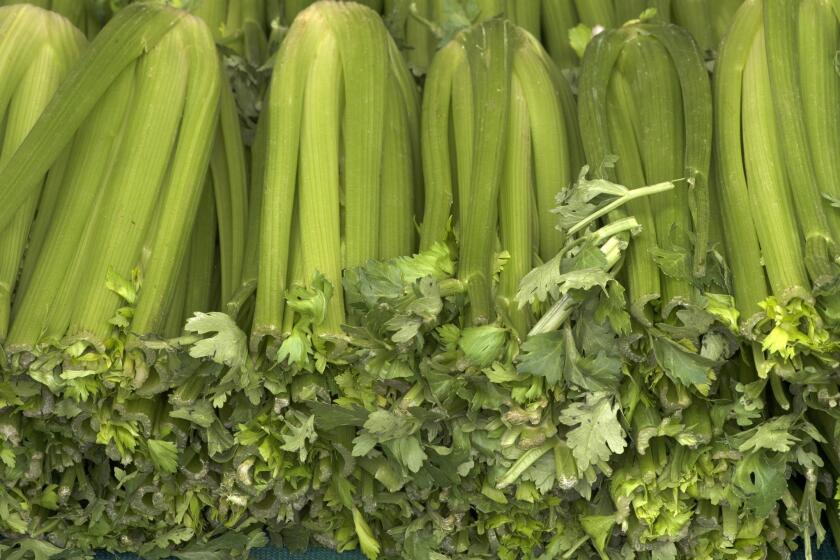Tomato fans: How you can get free ground cherries and goldenberries for your garden
- Share via
It’s pretty clear that Americans are tomato-crazy — a summer garden without tomato plants is as likely as the Fourth of July without flags. So why isn’t there more interest in their Physalis plant cousins, the husked fruit known as goldenberries, ground cherries and tomatillos?
Tomatillos are a staple in Mexican salsas and sauces, such as chili verde, and can be found in many supermarkets, but ground cherries and goldenberries are rarely grown in the U.S. these days, even though they were regulars in prairie settler gardens, as any Laura Ingalls Wilder fan can attest.
“They’re sweet, and kids love them,” said Joyce Van Eck, research and associate professor at Boyce Thompson Institute in Ithaca, N.Y. “Goldenberries actually have a sweet tart flavor, with undertones of coconut, mango and apricot. Ground cherries are sweet too, but not as complex. When we do our outreach, people expect them to taste like a cherry tomato, so they’re always surprised.”
Celery is today’s star vegetable. Here’s how to grow your own at home for taller stalks and more robust taste.
Moreover, ground cherries and goldenberries are easy to grow in the garden or in pots, and they’re prolific producers, Van Eck said. So her group is trying to build interest in the fruits to see if they can become a viable crop for farmers and gardeners.
Through Feb. 10, BTI is mailing free seeds to people who register to become “citizen scientists” in its Physalis Improvement Project by planting the seeds in their gardens and sending photos and reports about how their plants grow.
The free-seed program started in 2017 with 36 growers, primarily in the Northeast. About 60 gardeners and farmers signed on in 2018, and last year, 100 growers from all over the country got involved.
Four types of seeds are available this year, and gardeners can request any or all, Van Eck said. The choices include the tart Toma Verde tomatillo, the Colombia goldenberry and two types of ground cherries — one called Pineapple, named for its flavor, and the other called PHY 50. The researchers chose tried-and-true seeds that farmers have collected over the years for their flavor and ability to produce plenty of quality fruit, Van Eck said.
Blood oranges get used in this cake in three ways: zest in the cake batter, whole slices fried in butter for decoration, and fresh juice for a vibrant pink glaze.
Be prepared for big, rangy plants (up to 7 feet tall) with lots of husked fruit. Ground cherries and goldenberries are about the size of cherry tomatoes, Van Eck said. Tomatillos can grow larger, close to a medium-size tomato. If you plan to grow in pots, choose large containers and add a sturdy stake to keep the plants from falling over. Ground cherries and goldenberries are self-pollinating, but some tomatillos require other plants to pollinate, so plan on planting at least two.
Researchers believe that goldenberries originated in South America, in the Andes region of Peru. Today, Colombia is the largest producer and exporter, and goldenberries are its second largest export, just behind bananas, with crops going primarily to Europe and China. Ground cherries appear to have originated in North America, in Mexico, but pioneers like the Wilders found them growing wild in the Midwest. Researchers believe the seeds were brought up from their southern origins to other regions in the United States, Van Eck said.
Southern California is a good spot to grow Physalis, since the plants don’t like wet feet and prefer lots of sun. They grow quickly too: Seeds planted in April should start producing bountiful fruit in July. The researchers have even included recipes on their page, for things like chutneys, compotes and dried-fruit muffins and granola — all in the name of science.
The Physalis Improvement Project
What: Free seeds for gardeners who want to grow Physalis ground cherries, goldenberries and tomatillos
When: Register through Feb. 10
Info: btiscience.org
More to Read
Updates
1:40 p.m. Feb. 4, 2020: This story has been updated to reflect the new deadline, which has been extended from Feb. 7 to Feb. 10
Sign up for The Wild
We’ll help you find the best places to hike, bike and run, as well as the perfect silent spots for meditation and yoga.
You may occasionally receive promotional content from the Los Angeles Times.













